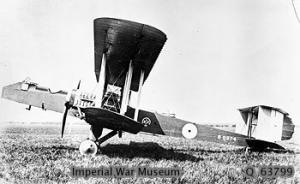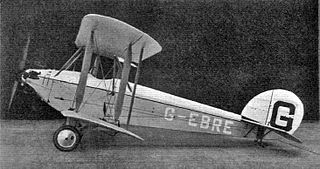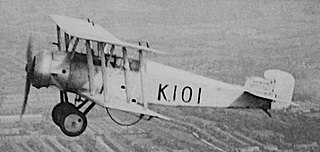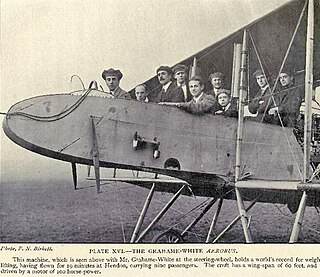Related Research Articles

The Sopwith Pup is a British single-seater biplane fighter aircraft built by the Sopwith Aviation Company. It entered service with the Royal Naval Air Service and the Royal Flying Corps in the autumn of 1916. With pleasant flying characteristics and good manoeuvrability, the aircraft proved very successful. The Pup was eventually outclassed by newer German fighters, but it was not completely replaced on the Western Front until the end of 1917. The remaining Pups were relegated to Home Defence and training units. The Pup's docile flying characteristics also made it ideal for use in aircraft carrier deck landing and takeoff experiments and training.

The Avro 504 was a First World War biplane aircraft made by the Avro aircraft company and under licence by others. Production during the war totalled 8,970 and continued for almost 20 years, making it the most-produced aircraft of any kind that served in any military capacity during the First World War. More than 10,000 were built from 1913 until production ended in 1932.
Grahame-White was an early British aircraft manufacturer, flying school and later manufacturer of cyclecars.

The Blackburn R.T.1 Kangaroo was a British twin-engine reconnaissance torpedo biplane of the First World War, built by Blackburn Aircraft.

The Le Rhône 9C is a nine-cylinder rotary aircraft engine produced in France by Société des Moteurs Le Rhône / Gnome et Rhône. Also known as the Le Rhône 80 hp in a reference to its nominal power rating, the engine was fitted to many military aircraft types during the First World War. Le Rhône 9C engines were also produced under license in Great Britain, the United States and Sweden.

The BAT F.K.23 Bantam was a British single-seat fighter biplane produced by British Aerial Transport Company Limited of London during World War I.

The Avro 534 Baby was a British single-seat light sporting biplane built shortly after the First World War.

The BAT F.K.24 Baboon was a British two-seat training biplane produced by British Aerial Transport Company Limited of London during World War I.

The BAT F.K.26 was a British single-engined four-passenger biplane transport aircraft produced by British Aerial Transport Company Limited of London at the end of World War I.

The Blackburn L.1 Bluebird was a British single-engine biplane light trainer/tourer with side-by-side seating, built in small numbers by Blackburn Aircraft in the 1920s.
The Pemberton-Billing P.B.25 was a First World War British single-seat scout aircraft built by Pemberton-Billing Limited, later Supermarine Aviation Works Limited.

The Sopwith Gnu was a 1910s British touring biplane, designed and built by the Sopwith Aviation & Engineering Company of Kingston-upon-Thames. It was one of the first cabin aircraft designed for civil use.

The Grahame-White Type X Charabanc or Aerobus was a 1910s British passenger-carrying biplane designed and built by the Grahame-White Aviation Company based at Hendon Aerodrome, North London.
The Avro 539 was a British single-seat racing biplane built by Avro for the 1919 Schneider Trophy.
The Grahame-White Ganymede was a prototype British heavy night bomber intended to serve with the Royal Air Force in the First World War. A large, three-engined, twin-boom biplane, the sole prototype Ganymede did not fly until after the war had ended, and although an attempt was made to convert the aircraft to an airliner, it was unsuccessful.
The Grahame-White G.W.E.7 was a British twin-engined transport biplane, designed by M Boudot and built by Grahame-White Aviation Company at Hendon.
The London and Provincial Fuselage Biplane was a British single-engined two-seat training aircraft of the First World War. While the aircraft demonstrated excellent manoeuvrability, only a single example was built.

The Sopwith Swallow was a British parasol wing fighter aircraft of the First World War. A single example was built, but it saw no production, offering no performance advantages over contemporary biplanes.
The Blériot-SPAD S.29 was a sport aircraft produced in 1919 by Blériot-SPAD.
The Caudron C.37 was a French three-engined biplane passenger transport, built in 1920. It could carry six passengers.
References
- Jackson, A.J. (1974). British Civil Aircraft since 1919 Volume 2. London: Putnam. p. 382. ISBN 0-370-10010-7.
- "An Interesting Grahame-White Sporting Model". Flight . XI (15): 468–473. 10 April 1919. No. 537. Retrieved 12 January 2011. Contemporary technical description with photographs and drawings.
- Riding, Richard (July 1979). "British pre-war ultra-lights: No 35: Grahame-White G.W.E.6 Bantam". Aeroplane Monthly . Vol. 7, no. 7. pp. 382–385.
- “The birthplace of aerial power”, Authors: Claude Grahame-White & Harry Harper. June